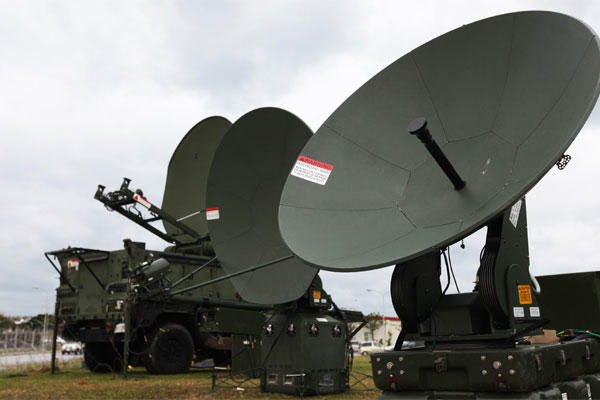CAMP HANSEN, Okinawa, Japan -- Surrounded by concertina wire and humming with continual activity, tan and olive-drab tents contain the integral workings of a deployed Marine Expeditionary Unit - all within Camp Hansen’s backyard.
Simulating forward-deployed operations, Marines of the 31st MEU’s communications section execute their semi-annual Communications Exercise adjacent to the communications shop here, Dec. 16 through 21.
Comprised of multiple tents and various pieces of equipment, the communications section is able to mirror their operational abilities and tasks while deployed for practice and sustainment. To ensure reliable functionality around the clock, the equipment is tested and scenarios are rehearsed prior to every deployment.
“It should take us under six hours between leaving the ship to being set up with fully-functioning equipment, which is what we practice during this exercise,” said Cpl. Bradley J. Kirk, radio operator with the radio platoon, communications section, command element, 31st MEU. “We are the information and internet hub for the unit, so proficiency in what we do for the MEU as a whole is vital.”
The deployed communications element looks simple at first glance with a couple of satellites, generators and tents. However, this deceiving simplicity hides a complex process by which Marines generate a communication network for the command staff. Three dishes stand to receive raw data from a satellite, funneling it into a score of servers that process and send that information to the data section. Once the data is formatted into necessary outlets, such as firewalls and computer servers, it is ready for internet utilization.
The main satellite dish, a Phoenix Tactical Super High Frequency Satellite Terminal, is a High-Mobility, Multi-Wheeled Vehicle-mounted dish that sends and receives transmissions to any sized Marine Air Ground Task Force and is considered the first-in communications resource. It has one back-up satellite, a smaller Support Wide Area Network dish, and an even smaller supplemental unit that communicates with satellites in burst transmissions.
“All you see is three satellites of varying sizes, but those are the main link between the MEU (headquarters) and all supporting units,” said Kirk, a native of Riverside, Calif. “Other than the radio communications we come right off the ship with, this set-up is the MEU’s number one communication priority.”
When it comes to commanding and controlling all subordinate units of the 31st MEU spread across multiple areas and back on ship, such communication capabilities are important to mission accomplishment.
“Without the capabilities we have now, the mission would still be accomplished doctrinally and by commander’s intent, but it would be drastically slower,” said Master Sgt. Aaron B. Cranford, communications chief for the communications section, command element, 31st MEU and a native of Marion, N.C. “As soon as we’re done with this exercise, we’ll be planning for the next one, keeping our Marines fresh and ready on the gear.”
To add to the importance of the training, the communications section recently underwent a significant changeover in personnel with two-thirds of the junior enlisted Marines fresh out of communications school and new to the fleet. The exercise now plays a dual purpose of not only refreshing skills but also teaching those skills to the new members.
“In communications school, most of the training is virtual; there’s not a lot of hands on application,” said Lance Cpl. Jordan B. McNeal, data network specialist with the data platoon, communications section, command element, 31st MEU and a native of Miamisburg, Ohio. “It’s a whole different ball game when you’re working with this kind of equipment and effectively employing it in the field. While we’re checking the gear and refreshing our skills, we’re also passing them along to the new-joins and bringing them up to speed with how our section operates within the 31st MEU.”
The Communications Exercise preludes the upcoming regularly scheduled 31st MEU Spring Patrol, where the MEU will conduct bilateral training events within the Asia-Pacific region.
The 31st MEU is the only continuously forward-deployed MEU and is the Marine Corps’ force in readiness in the Asia-Pacific region.



























